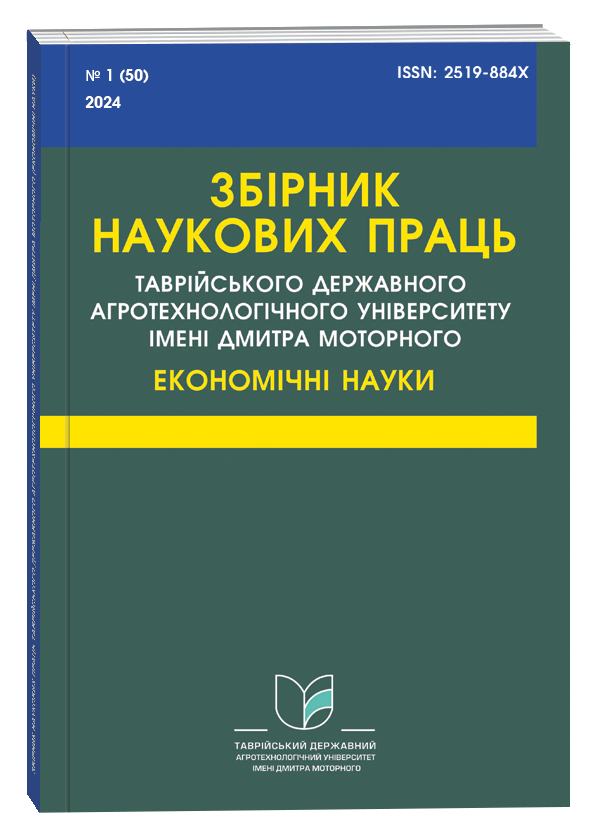МОДЕЛЮВАННЯ НОВОГО БІЗНЕС-СЕРЕДОВИЩА АГРАРНОГО ВИРОБНИЦТВА В УМОВАХ ПЕРЕХОДУ ДО ЗЕЛЕНОЇ ЕКОНОМІКИ
Анотація
Обґрунтовано методичні положення до моделювання нового бізнес-середовища аграрного виробництва та підкреслено цінність природи, яка генерує земельні ресурси для фундаментальних переваг життєзабезпечення сільських територій та передбачення ризику руйнування екосистеми. Перехід стандартної моделі аграрного виробництва на нові рейси зеленої економіки в Україні означатиме зміну економічного зростання суб’єктів аграрного бізнесу в новому напрямі, що одночасно гарантуватиме стабільність екосистеми регіонів на засадах ефективності використання земель сільськогосподарського призначення, екологізації виробництва, зростання добробуту людських ресурсів в сільській місцевості та соціальну відповідальність за відновлювання енергії, за посилення ролі держави у стимулюванні зелених інвестицій та інновацій, за створення умов до підвищення конкурентоспроможності національних товаровиробників зеленої продукції та формування нового ставлення сільського населення до аграрного виробництва.
Посилання
Bespalko, R. I., Hryschuk, S. Yu. (2013). Problematic issues of land use optimization. Geodesy, cartography and aerial photography, 78, 226–229.
Gronska, M. V. (2014). Rational use of agricultural lands through the prism of organizational and legal support. Bulletin of the Petro Vasylenko Kharkiv National Technical University of Agriculture, 149, 128–136.
Dorosh, O. S., Kupriyanchyk, I. P. (2016). The role of socio-economic and institutional components in the formation and functioning of agricultural holdings in Ukraine. Land management, cadastre and land monitoring, 3, 12–19.
Green post-war recovery of Ukraine: vision and models (2022). Analytical note. "Resource-Analytical Center "Society and Environment".
Kaminetska, O. V. (2017). Economic theories of well-being as the basis of efficiency and fairness of social distribution of land resources. Formation of market relations in Ukraine, 2(189), 66–72.
Kireitseva, O. V. (2016). Modern trends in the functioning of the land market in France. International scientific journal "Internauka", 12(2), 74–76.
Libanova, E. M., Khvesyk, M. A. (2014). Socio-economic potential of sustainable development of Ukraine and its regions. Kyiv: TU TEPSR NAS of Ukraine.
Ukraine joined the UN Food Security Committee (2021). URL: https://www.kmu.gov.ua/news/ukrayina-priyednalasya-do-komitetu-z-vsesvitnoyi-prodovolchoyi-bezpeki-fao
Ukraine: rapid assessment of damage and recovery needs (2022). Cvitovyi Bank, Uriad Ukrainy, Yevropeiska Komisiia. URL: https://www.minregion.gov.ua/wp-content/uploads/2022/09/zvit-shvydka-oczinka-zavdanoyi-shkody-ta-potreb-na-vidnovlennya_-ukr-1.pdf
Amit, R., Zott, C. (2012). Creating value through business model innovation. MITSLOAN Management Review, Magazine: Spring. URL: https://sloanreview.mit.edu/article/creating-value-through-business-model-innovation/
Baas, L. (2008). Industrial symbiosis in the Rotterdam Harbour and Industry Complex: reflections on the interconnection of the techno-sphere with the social system. Business Strategy and the Environment, 17, 330–340.
Blanco, E., Razzaque, J. (2012). Natural Resources and the Green Economy: Redefining the Challenges for People. Leiden-Boston: Martinus Nijhoff Publishers. URL: https://books.google.com.ua/books/about/Natural_Resources_and_the_Green_Economy.html?id=y_TZNgmMz94C&redir_esc=y
D'Amato, D., Korhonen, J. (2021). Integrating the green economy, circular economy and bioeconomy in a strategic sustainability framework. Ecological Economics, 188, 107143. DOI: https://doi.org/10.1016/j.ecolecon.2021.107143
Eckerberg, K., Mineur, E. (2003). The Use of Local Sustainability Indicators: case studies in two Swedish municipalities. Local Environment, 8(6), 591–614.
Fischer-Kowalski, M. (2011). Decoupling natural resource use and environmental impacts from economic growth. A Report of the Working Group on Decoupling to the International Resource Panel. UNEP.
Hallstedt, S. I., Broman, G. I, Robèrt, K.-H. (2007). A method for sustainable product development based on a modular system of guiding questions. Journal of Cleaner Production, 15, 1–11.
Harris, J. (2019). Green Keynesianism: Beyond Standard Growth Paradigms. GDAE Working Paper, 13-02. URL: https://www.bu.edu/eci/files/2019/06/13-02HarrisGreenKeynesianism.pdf
Lee, J.-Y., Marotzke, J., Bala, G., Cao, L., Corti, S., Dunne, J.P., Engelbrecht, F., Fischer, E., Fyfe, J.C., Jones, C., Maycock, A., Mutemi, J., Ndiaye, O., Panickal, S., Zhou, T. (2021). Future Global Climate: Scenario-Based Projections and Near-Term Information. Cambridge, United Kingdom and New York, NY, USA, 553–672.
Беспалько Р. І., Хрищук С. Ю. Проблемні питання оптимізації використання землекористувань. Геодезія, картографія і аерофотознімання. 2013. Вип. 78. С. 226–229.
Гронська М. В. Раціональне використання земель сільськогосподарського призначення через призму організаційно-правового забезпечення. Вісник Харківського національного технічного університету сільського господарства імені Петра Василенка. 2014. Вип. 149. С. 128–136.
Дорош О. С., Купріянчик І. П. Роль соціально-економічної й інституційної складових у формуванні й функціонуванні агрохолдингів в Україні. Землеустрій, кадастр і моніторинг земель. 2016. № 3. С. 12–19.
Зелене повоєнне відновлення України: візія та моделі. Аналітична записка. «Ресурсно-аналітичний центр «Суспільство і довкілля». 2022.
Камінецька О. В. Економічні теорії добробуту як основа ефективності та справедливості суспільного розподілу земельних ресурсів. Формування ринкових відносин в Україні. 2017. № 2(189). С. 66–72.
Кірейцева О. В. Сучасні тенденції функціонування ринку землі у Франції. Міжнародний науковий журнал «Інтернаука». 2016. № 12(2). С. 74–76.
Лібанової Е. М., Хвесика М. А. Соціально-економічний потенціал сталого розвитку України та її регіонів. Київ : ДУ ТЕПСР НАН України, 2014. 776 с.
Україна увійшла до комітету продовольчої безпеки ООН. 2021. URL: https://www.kmu.gov.ua/news/ukrayina-priyednalasya-do-komitetu-z-vsesvitnoyi-prodovolchoyi-bezpeki-fao
Україна: швидка оцінка завданої шкоди та потреб на відновлення. Cвітовий Банк, Уряд України, Європейська Комісія. 2022. 269 с. URL: https://www.minregion.gov.ua/wp-content/uploads/2022/09/zvit-shvydka-oczinka-zavdanoyi-shkody-ta-potreb-na-vidnovlennya_-ukr-1.pdf
Amit R., Zott C. Creating value through business model innovation. MITSLOAN Management Review, Magazine: Spring. 2012. URL: https://sloanreview.mit.edu/article/creating-value-through-business-model- innovation/
Baas L. Industrial symbiosis in the Rotterdam Harbour and Industry Complex: reflections on the interconnection of the techno-sphere with the social system. Business Strategy and the Environment. 2008. Vol. 17. pp. 330–340.
Blanco E., Razzaque J. Natural Resources and the Green Economy: Redefining the Challenges for People. Leiden-Boston: Martinus Nijhoff Publishers. 2012. 272 p. URL: https://books.google.com.ua/books/about/Natural_Resources_and_the_Green_Economy.html?id=y_TZNgmMz94C&redir_esc=y
D'Amato D., Korhonen J. Integrating the green economy, circular economy and bioeconomy in a strategic sustainability framework. Ecological Economics. 2021. Vol. 188. pp. 107143. URL: https://doi.org/10.1016/j.ecolecon.2021.107143
Eckerberg K., Mineur E. The Use of Local Sustainability Indicators: case studies in two Swedish municipalities. Local Environment. 2003. Vol. 8(6). pp. 591–614.
Fischer-Kowalski M. Decoupling natural resource use and environmental impacts from economic growth. A Report of the Working Group on Decoupling to the International Resource Panel. UNEP. 2011. 174 p.
Hallstedt S. I., Broman G. I., Robèrt K.-H. A method for sustainable product development based on a modular system of guiding questions. Journal of Cleaner Production. 2007. Vol. 15. pp. 1–11.
Harris J. Green Keynesianism: Beyond Standard Growth Paradigms. GDAE Working Paper. 2019. Vol. 13–02. URL: https://www.bu.edu/eci/files/2019/06/13-02HarrisGreenKeynesianism.pdf
Lee J.-Y., Marotzke J., Bala G., Cao L., Corti S., Dunne J.P., Engelbrecht F., Fischer E., Fyfe J.C., Jones C., Maycock A., Mutemi J., Ndiaye O., Panickal S., Zhou T. Future Global Climate: Scenario-Based Projections and Near-Term Information. Cambridge, United Kingdom and New York, NY, USA, 2021, pp. 553–672.

